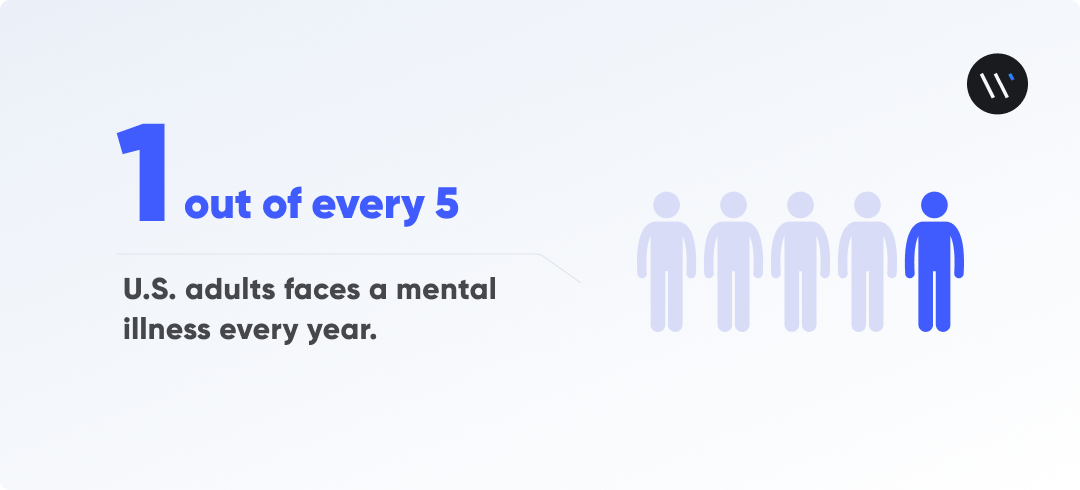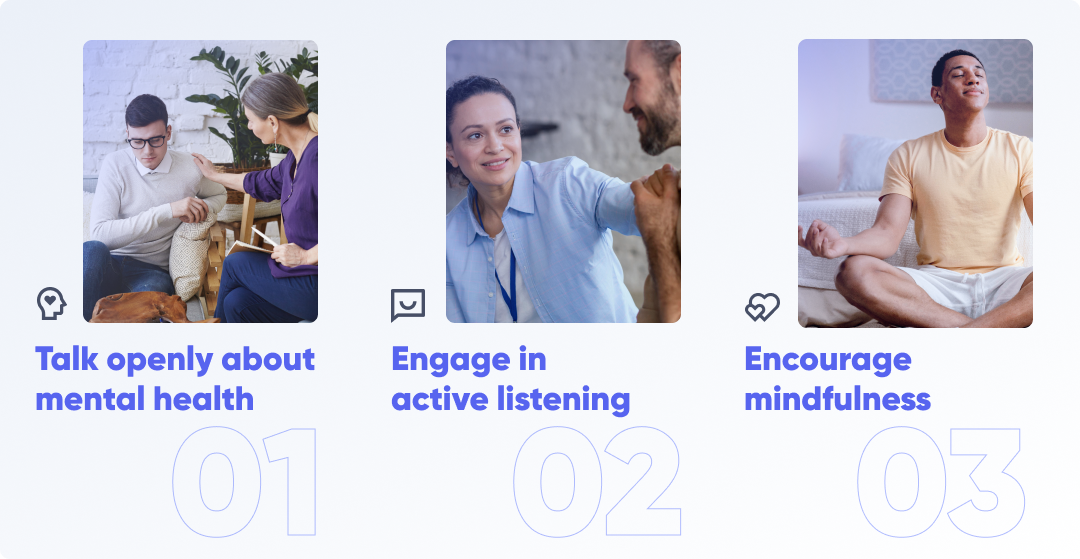When you ask your team “How are you feeling?” what responses do you receive?
If you get a simple “I’m good!” or worse, crickets, then there may be some underlying issues that you can start to uncover, especially as it relates to your direct reports’ mental health.
While conversations surrounding mental illness have been normalized on social media, the topic is still relatively taboo in the workplace. Employees want to present their best, most professional selves when they’re on the job. Understandably, many of them don’t feel comfortable divulging personal details about their feelings of overwhelm, stress, and anxiety, let alone their mental health state.
This is a problem for organizations. When employees continue going about their days without adequate resources and a transparent culture that helps them to feel comfortable speaking up and sharing their thoughts, it harms both their personal and professional lives.
The good news is that companies have more opportunities than ever before to support employee mental health. Leveraging the latest technology allows organizations to help their managers and their teams access the type of support they need whenever they need it.
Before digging into the digital tools that effectively promote employee mental health, it’s important to first gain a better understanding of just how many employees are affected by mental illness.
Understanding mental illness
Most people experiencing a mental illness don’t make it well known. They don’t want to feel judged, pitied, or viewed as a burden to others. As a result, organizations don’t realize just how many of their employees are affected. So, how common is mental illness?
A study from the Substance Abuse and Mental Health Administration (SAMHA) reveals that 1 out of every 5 U.S. adults faces a mental illness every year. The rate is even higher for those between the ages of 18 and 25, reaching almost 30%. Some of the conditions that fall under this umbrella include depression, bipolar disorder, anxiety disorders, and post-traumatic stress disorder (PTSD).
 Despite how common mental illness is, the same SAMHA study shows that less than 50% of adults affected by mental illness receive treatment for it. The report data tables show that some of the primary reasons people cite for choosing not to seek mental health services include:
Despite how common mental illness is, the same SAMHA study shows that less than 50% of adults affected by mental illness receive treatment for it. The report data tables show that some of the primary reasons people cite for choosing not to seek mental health services include:
- They couldn’t afford it
- They didn’t know where to go for treatment
- They didn’t have enough time
- They lacked sufficient health insurance coverage
- They worried others would think negatively of them
Forgoing treatment can negatively affect quality of life and it also has implications for job performance. In fact, serious mental illness results in $193.2 billion in lost earnings across the economy each year.
Examining the role companies play in supporting employee mental health
When it comes to providing the type of mental health support employees need, companies should take stock of where they are today. Some organizations already have workplace wellness programs that provide mental health resources and a structured way to start normalizing these conversations about mental wellness at work. Others may be considering mental health benefits for the first time ever.
Regardless of where your company is, there are a few primary steps you can take taking a more proactive approach to supporting employee mental health.
1. Provide mental wellness resources and education
According to a McKinsey & Company report, about 70% of employers plan to start offering, continue offering, or expand mental health benefits. While this is encouraging, these types of offerings sometimes get a bad rap for being underutilized.
But don’t let efforts that have fallen short in the past prevent you from prioritizing mental health offerings. It could be that the specific benefits didn’t resonate with employees. Or perhaps your team simply isn’t aware of all the options available to them.
To get a sense of what type of mental health support employees would like, start by polling them. Anonymous surveys can be a great way to gain honest feedback. Be open to comments and suggestions as well — your employees may know of a specific app or platform that isn’t yet on your radar.
It’s also important to consistently remind your team of the resources that are already available to them through meetings, emails, and other internal communication tools.
2. Improve access to these resources and information
Given that many adults lack the time or the knowledge of how to seek adequate support, employers have an opportunity to help. Technology has made it possible to offer virtual alternatives to many in-person services that can be accessed on a computer or mobile device.
Some organizations are already moving in the right direction. A survey from the Business Group on Health reports that 54% of employers plan to offer free or low-cost virtual mental health services. With virtual services, employees can access resources from the comfort of their own homes. Better yet, they don’t need to worry about transportation or taking time off work.
3. Build a culture of support and psychological safety
Most importantly, companies can support employees by infusing mental health support into the company culture. Executives and managers have the opportunity to share their own stories and model how disclosing mental illness can be empowering. When leaders talk openly about mental health, engage in active listening, and encourage mindfulness, it sends a clear signal that they care about supporting employee well-being.
This type of open and honest sharing helps to create a psychologically safe work environment. Psychological safety, a concept introduced by behavior scientist Dr. Amy Edmondson, is “a shared belief held by members of a team that the team is safe for interpersonal risk-taking.” When team members feel safe at work, they’re able to share their thoughts and suggest solutions without fear of judgment.
 You can even consider fostering a more welcoming and inclusive environment by incorporating team-wide wellness practices into the workday. Try starting meetings with a quick meditation. You could also take an all-team stretch break to help ensure everyone is taking some time to get away from their screens for a bit.
You can even consider fostering a more welcoming and inclusive environment by incorporating team-wide wellness practices into the workday. Try starting meetings with a quick meditation. You could also take an all-team stretch break to help ensure everyone is taking some time to get away from their screens for a bit.
Uncover how technology can improve employee mental health
As for the role technology plays in supporting mental health, there’s already quite a bit of promising research. Some studies have shown that digital tools improve access for underserved and marginalized communities. Digital platforms also make it easier for people to self-monitor in a way that has previously not been possible.
One particularly good example of how technology has revolutionized mental health care is something called “telepsychiatry.” You can think of telepsychiatry as the videoconferencing version of an office visit to a psychiatrist. Like an in-person appointment, you can receive an evaluation, attend therapy, and get guidance on next steps.
Research shows that telepsychiatry has proven to achieve high patient satisfaction rates. Most patients say it’s equivalent to face-to-face sessions. It’s also more cost-effective than traditional psychiatry.
Technology and apps that promote resilience in the workplace
There are many different types of tools you can choose from to help support employee mental health, but most of them fall under a handful of categories. Some are easier to implement than others but keep in mind that taking the time to research these options and determine what best meets your team’s needs will pay off in the long run.
📱 Mobile apps — Today’s wellness apps focus on everything from meditation to specific disorders. There are also options to connect with qualified experts. Best of all, mobile apps make it possible to find resources on the go.
📺 On-demand videos — Like pre-recorded fitness classes, on-demand wellness sessions are available to employees at any time. Topics can include mindfulness, gratitude, stress relief, anger management, and more. On-demand videos are also useful in that the time is predetermined, which allows users to select something short if they only have a few minutes to spare.
🙋 Live classes and workshops — Some employers choose to host internal webinars or workshops for their employees, but there are many live classes already available through different platforms or organizations. For example, the National Alliance on Mental Illness (NAMI) has chapters all across the U.S. that host a variety of classes and workshops.
🗨 Virtual wellness communities — Employees with a mental illness can find the experience isolating, so online communities can be incredibly beneficial for helping them feel supported. Engaging with like-minded people can also help provide motivation. There are many different options for wellness communities focused on particular health conditions, different population groups, and specific goals.
👩💻 Telehealth services — Providing options for connecting with qualified mental health providers online in real-time can be incredibly beneficial for employees who might otherwise not make it to an office visit. Telehealth services allow them to attend therapy and coaching sessions that are tailored specifically to their needs.
💻 Robust digital wellness platforms — For many organizations, piecing together different tools can be burdensome. These types of employers can really benefit from an all-inclusive digital wellness platform like Wellness Coach, which includes live and on-demand classes, access to certified coaches, guided meditations, custom challenges, private coaching, and more.
Strengthen and support your team to build resilience in the workplace
It’s clear that companies can do a lot to address mental illness among their employees and ultimately build resilience in the workplace. When employees have support and resources to address their mental health needs, they’re more likely to be engaged, motivated, and excited to show up each day.
Because there are so many digital tools that focus on wellness, the difficult part isn’t finding a solution but finding the right solution for your team. With Wellness Coach, you can actively support employee mental health through the tools your team already uses to collaborate and stay connected throughout the day.
Whether your preferred platform is Zoom, Microsoft Teams, or Slack, you can integrate the Wellness Coach platform to ensure your team has access to expert coaching and tools to support their overall well-being. These integrations benefit employees individually, but also support team-wide connection and engagement.
You could make prioritizing mental health the norm at your company. Find how to get started with a free demo of Wellness Coach.
.png)

.svg) Share
Share.svg) Tweet
Tweet.svg) Post
Post.svg) Mail
Mail